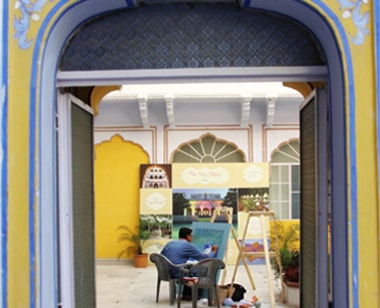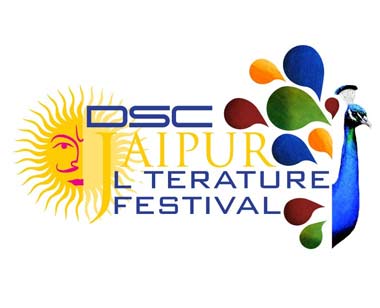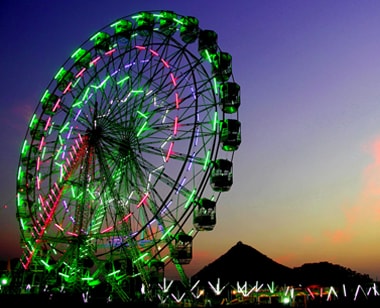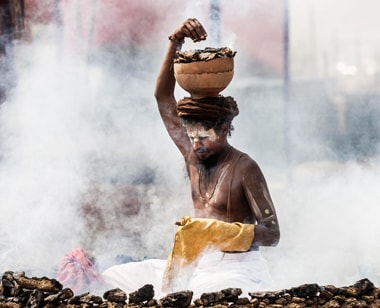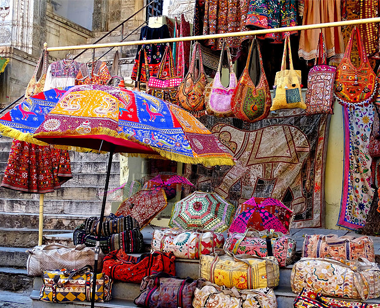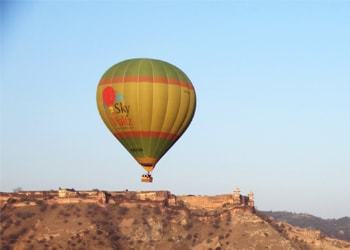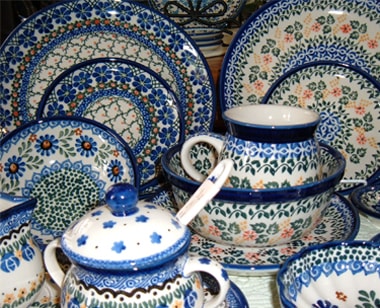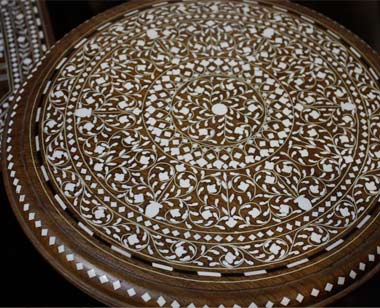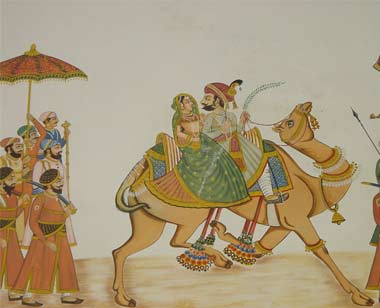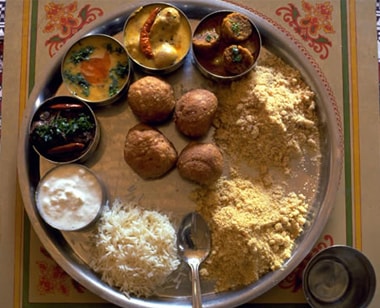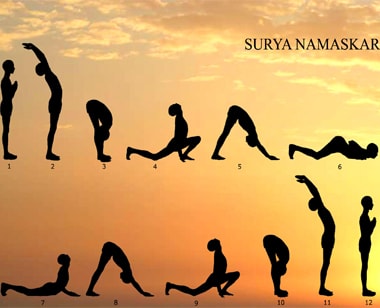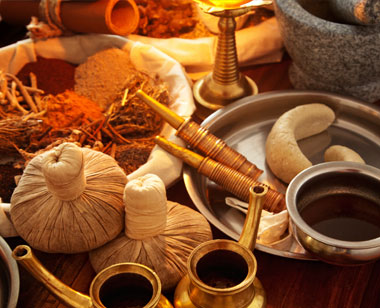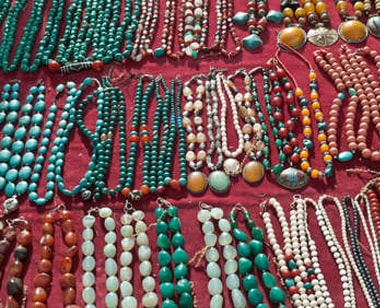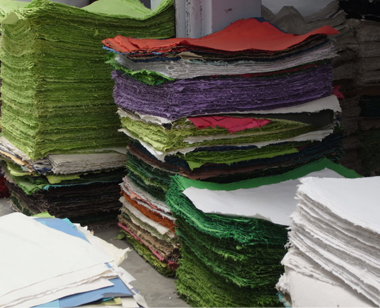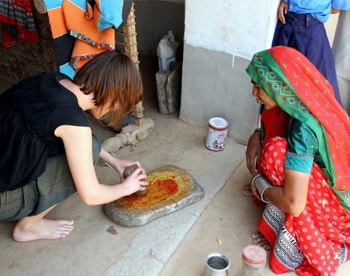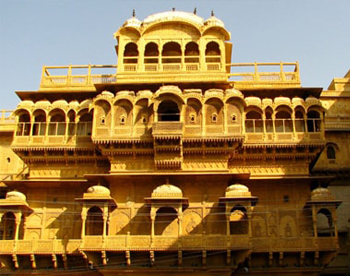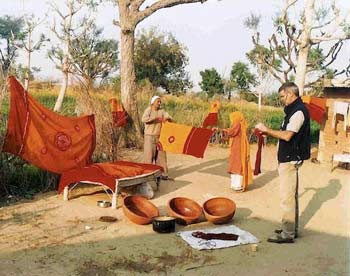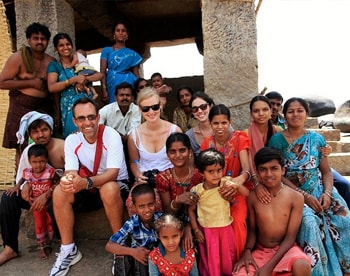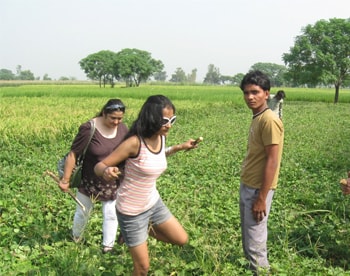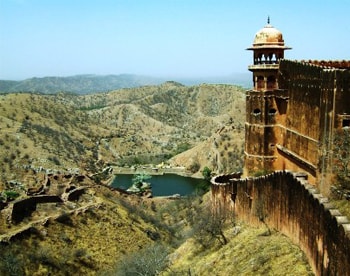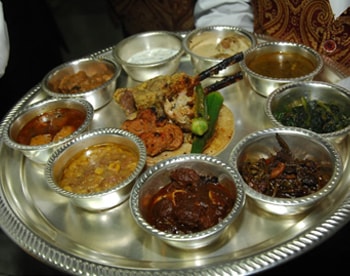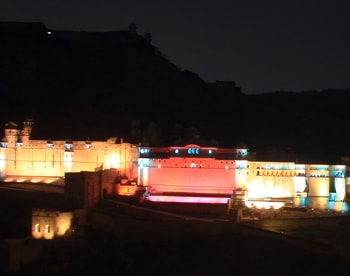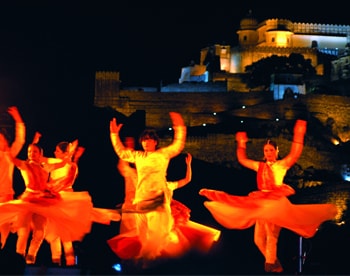THE GOLDEN FORT
The Golden Fort or “Sonar Kila”, built of sandstone of the jurrassic period on the Trikuta Hill ( the tripple peaked hill ). It grows out of a rock in an undulating sea of sand. The imposing fort is awe-inspiring protected by rugged high walls,approachable through four successive gates, the Akhaiy Pol, the Ganesh Pol, the Suraj Pol and the Hawa Pol. The palaces of the rulers built atop the main entrance, from an imposing edifice crowned by a huge umbrella of metal mounted on a stone shaft. The fort also houses many old Hindu as well as Jain temples and beautifully carved havelis. The entire living area is well protected within the ramparts of the fort.
Tourist Places
PATAWA HAVELI
One of the most exquisite buildings in the walled city, which truly exemplifies the architectural style typical of erstwhile Rajputana. It is five storeys high and the extensive corridors and chambers are supported by intricately carved pillars.
PATAWA HAVELI
One of the most exquisite buildings in the walled city, which truly exemplifies the architectural style typical of erstwhile Rajputana. It is five storeys high and the extensive corridors and chambers are supported by intricately carved pillars.
PATAWA HAVELI
One of the most exquisite buildings in the walled city, which truly exemplifies the architectural style typical of erstwhile Rajputana. It is five storeys high and the extensive corridors and chambers are supported by intricately carved pillars.
PATAWA HAVELI
One of the most exquisite buildings in the walled city, which truly exemplifies the architectural style typical of erstwhile Rajputana. It is five storeys high and the extensive corridors and chambers are supported by intricately carved pillars.
PATAWA HAVELI
One of the most exquisite buildings in the walled city, which truly exemplifies the architectural style typical of erstwhile Rajputana. It is five storeys high and the extensive corridors and chambers are supported by intricately carved pillars.
NATHMAL KI HAVELI
Carved by Lalu and Hathi, two brothers for the Prime Minister of State, Nathmalji in 19th century. The most interesting fact is that the brothers worked separately, one on the right side and other on the left side, the result is a absolute symphony epitomising the side by side symmetry during construction. The haveli is richly carved and the inner chambers are decorated with miniature paintings.
MANDIR PALACE
The excellent palace complex located near Amar Sagar gate , is the house of former royal family. The Tazia Tower rising from the palace is the landmark for the town. The building forms are interesting and the facades are richly carved.
SALIM SINGH KI HAVELI
The five stroryed structure dominates the skyline of the walled city due to its form. It was built some 200 years age by Salim Singh, a powerful Chief Minister of Jaisalmer. The haveli begins with a narrow dimension below with an elaborate projecting balcony on the top storey. It is distinguished by the blue cupola roof.
GADSISAR LAKE
This rainwater lake was once the major supplier of potable water in the town. Today it is a big attraction for the picnickers in the desert city. Sacred shrines and well-laid gardens flank the lake. A varied collection of beautiful brides can be observed fluttering about over here.
AMAR SAGAR LAKE(Location: 7 K.M. in the western outskirts of Jaisalmer)
How to reach: Hire a cab or share an Auto-rickshaw Attractions: Lake and a Palace Amar Sagar is a small and beautiful lake cum Oasis and is adjacent to a 17th Century palace called the Amar Singh Palace. Maharawal Akhai Singh built this palace in honor of one of his predecessors Amar Singh. Next to the palace are pavilions with a large stairs leading down to the Amar Sagar Lake. This haveli has been constructed in the pattern of apartments. The Amar Sagar is a five story high haveli and is famous for its murals. Wherever you go in this haveli, you will notice beautiful murals painted with delicate efforts. You can find many of wells and ponds in the surrounding which have a royal air about them. There is an old Shiva temple in the complex itself. Amar Singh built this because he was supposed to be an ardent follower of Lord Shiva, a Hindu God related to destruction.
KULDHARA(Distance : 27 kms west of Jaisalmer )
The Village kuldhara was formed by a Paliwal person named Kuldhar and on his name the village is known as Kuldhara. The Village is now abondand and behind this there were so many stories in the air among these a very popular and strong one is that … Deewan of that time Salim Singh was was a very rude and tourturing personality to get rid of all this the villagers of 84 villages near by Kuldhara took a bitter decision to leave the place on a perticular day and they did it and left the place all togather. Because of all this the village is now abondand but its The village is also known for its architecture and water conservation techniques. Thw Magsase award winner Mr. Rajendra singh also put efforts to adopt the water conservation techniques of this village because its an exaple of better water coservation techniques. The village was having 5000 population and there was only one temple which shows that there was a uniformity in the vision and where is a uniformity there is a way of Success.
LUDARWA(Distance : 13 kms North-west of Jaisalmer )
It is also kknown as ancient Capital of Jaisalmer, but it is more famous for the Jain temples and Kalp Vraksh (The wish tree). The architecture and carving on the stones is faboulus. This place is having very high relegious values for the Jain community the Lidrwa is among there main relegious places. every year somany Jain peoples come to here for their worship. The wole temple is having very fine carving on every piece of stone used to construct the temple.
BARABAGH(Distance : 7 kms North of Jaisalmer )
Bada Bagh which literally means ‘Big Garden’ is located on the Ramgarh road. It was commissioned by Maharawal Jait Singh in the early 16th century and completed by his son Lunakaran after his death. The site itself consists of a tank, a dam and a garden. Nearby you will find the Govardhan Stambh (pillar) on which are engraved the names of the dam and the water tank which are called the Jait Bandh and the Jaitsar respectively, dedicated to the man who constructed them. The Jait Bandh is a colossal structure, about 1,200 feet in length and 350 feet in width and built out of solid blocks of stone, as are the stepwells. On the nearby hill lie the imperial chhatris or cenotaphs of the rulers – a tribute to the valourous Bhatti dynasty. The oldest among them are the cenotaphs of Maharawal Jait Singh and his predecessor Devidas who reigned from 1470-1506. The newest cenotaph is that of Jawahar Singh who was Maharawal at the time of Indian independence. Jawahar Singh’s chhatri was left incomplete as his son died within a year of his accession to the throne which was considered a bad omen by the family. From then on the practice of building a valedictory memorial to the ruling clan has been discontinued.
SAM SAND DUNES(Distance : 45 kms west of Jaisalmer )
Undoubtedly the most well known destination in Jaisalmer after the ‘golden fort’, the Sam Sand dunes are a tourist hot spot in more ways than one. 3km long, 1km wide and as much as half a kilometer high, the dunes are as treacherous as they are scenic. The rippling sand miles upon miles at Sam is spell binding, alluring the tourists from all over the world. The shifting sand dunes are spread all over and everchanging. The camel safaris give one, a first hand feel of the desert life. The place is also a photographers delight and a popular site for shooting of feature films. The sunset point is an unforgettable experience. There is no point coming to the Thar Desert if you don’t go for the Desert Safari. That is why Sam sand dunes are becoming the major attraction in Jaisalmer. This is the closest place from where you can loose yourself in ‘the Great Thar Desert’. Sam has a truly magnificent stretch of sweeping dunes, with sparse or no vegetation. The best way to get here, of course, is on camelback. Join a camel caravan at Jaisalmer on your Rajasthan tours and ride along the breathtaking crests and troughs. Enjoy the romance of solitude as your camel takes you deep in the hearts of the Thar Desert. Put yourself in the camp and experience the sun setting behind the horizon. Organize a bonfire with the fellow tourists in the night and enjoy the rustic and earthy music and dance of Rajasthan. In the month of February/March, this whole place turns into a cultural hub. The desert festival organized amid these dunes is the showcase of Rajasthani culture as a whole. Open-air cultural extravaganzas, puppet shows, folk dance performances, camel races, competitions and general festivities mark this annual event that is held with great pomp and show at the Sam Sand dunes in Jaisalmer, Rajasthan.
AKAL WOOD FOSSILS PARK
Millions of years the ocean submerged ago Jaisalmer, and the discovery of seashells here emphasizes that belief. The wood fossils at Akal (17 km off the city on the Jaisalmer-Barmer road) are an example of the fossilization archaeologists say occurred 180 million years ago. The story goes that entire forests were so petrified of something that they were converted into stone. The fossils are said to represent non-flowering plants and provide a clue to the age of the deposition of sediments. At nearby Kandiala the deposits are probably older, but historians have been unable to ascribe a date to it.
Coming Soon
Major Attractions:
(1) Jaisalmer Fort
(2) Gadisar Lake
(3) Patwon ki Haveli (architecture)
(4) Salim Singh ki Haveli (architecture)
(5) Nathmalji ki Haveli (architecture)
(6) Tazia Tower
(7) Ramdevra
(8) Pokaran
(9) Bhadariya Mata Temple
(10) Sam Sand Dunes
(11) Kuldhara Village
(12) Khaba Village
(13) Khuri Sand Dunes
(14) Jain Temple & Jaisalmer Fort
(15) Ghadisar lake & Govt. & Folk Museum
(16) Patwon ki Haveli
(17) Nathmal ki Haveli
(18) Salam Singh ki Haveli
(19) Mandir Palace (Tazia Tower)
(20) Bada Bagh
(21) Amar Sagar Loudrva
(22) Akal Wood Fossil‟s Park
(23) Desert National Park
Major Day-excursions:
(1) Lodurva Temples (16 Kms)
(2) Sam Sand Dunes (42 Kms)
(3) Akal Fossil Park (17 Kms)
(4) Desert National Park (45 Kms)
(5) Khuri Village Safari (50 Kms)
(6) Ramdeora temple (100 Kms)
 +919828167660, +919414075013
+919828167660, +919414075013

